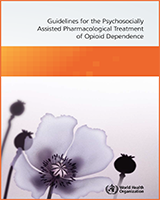All rights reserved. Publications of the World Health Organization can be obtained from WHO Press, World Health Organization, 20 Avenue Appia, 1211 Geneva 27, Switzerland (tel.: +41 22 791 3264; fax: +41 22 791 4857; e-mail: tni.ohw@sredrokoob). Requests for permission to reproduce or translate WHO publications – whether for sale or for noncommercial distribution – should be addressed to WHO Press, at the above address (fax: +41 22 791 4806; e-mail: tni.ohw@snoissimrep).
NCBI Bookshelf. A service of the National Library of Medicine, National Institutes of Health.
Overview
The Guidelines for the psychosocially assisted pharmacological treatment of opioid dependence review the use of medicines such as methadone, buprenorphine, naltrexone and clonidine in combination with psychosocial support in the treatment of people dependent on heroin or other opioids. Based on systematic reviews of the literature and using the GRADE approach to determining evidence quality, the guidelines contain specific recommendations on the range of issues faced in organizing treatment systems, managing treatment programmes and in treating people dependent on opioids.
Contents
- Acknowledgements
- Abbreviations and acronyms
- Executive summary
- 1. Scope and purpose
- 2. Method of formulating recommendations
- 3. Background
- 3.1 Opioid dependence
- 3.2 Neurobiological aspects of opioid dependence
- 3.3 Epidemiology of illicit opioid use and dependence
- 3.4 Harms associated with opioid use
- 3.5 Economic consequences of opioid use
- 3.6 Natural history of opioid dependence
- 3.7 Opioid dependence as a medical condition
- 3.8 Treatment of opioid dependence
- 4. Guidelines for health systems at national and subnational levels
- 5. Programme level guidelines – for programme managers and clinical leaders
- 6. Patient level guidelines – for clinicians
- 6.1 Diagnosis and assessment of opioid dependence
- 6.2 Choice of treatment approach
- 6.3 Opioid agonist maintenance treatment
- 6.4 Management of opioid withdrawal
- 6.5 Opioid antagonist (naltrexone) treatment
- 6.6 Psychosocial interventions
- 6.7 Treatment of overdose
- 6.8 Special considerations for specific groups and settings
- 6.9 Management of pain in patients with opioid dependence
- Annex 1 Evidence profiles
- Annex 2 Dispensing, dosing and prescriptions
- Annex 3 ICD-10 codes for conditions covered in these guidelines
- Annex 4 Pharmacology of medicines available for the treatment of opioid dependence
- Annex 5 Drug interactions involving methadone and buprenorphine
- Annex 6 Alternatives for the treatment of opioid dependence not included in the current guidelines
- Annex 7 Methadone and buprenorphine and international drug control conventions
- Annex 8 Priorities for research
- Annex 9 Background papers prepared for technical expert meetings to inform guideline development
- Annex 10 Opioid withdrawal scales
- Annex 11 Summary of characteristics of selected psychoactive substances
- Annex 12 Prescribing guidelines
- Annex 13 Glossary
- References
The designations employed and the presentation of the material in this publication do not imply the expression of any opinion whatsoever on the part of the World Health Organization concerning the legal status of any country, territory, city or area or of its authorities, or concerning the delimitation of its frontiers or boundaries. Dotted lines on maps represent approximate border lines for which there may not yet be full agreement.
The mention of specific companies or of certain manufacturers' products does not imply that they are endorsed or recommended by the World Health Organization in preference to others of a similar nature that are not mentioned. Errors and omissions excepted, the names of proprietary products are distinguished by initial capital letters.
All reasonable precautions have been taken by the World Health Organization to verify the information contained in this publication. However, the published material is being distributed without warranty of any kind, either expressed or implied. The responsibility for the interpretation and use of the material lies with the reader. In no event shall the World Health Organization be liable for damages arising from its use.
- NLM CatalogRelated NLM Catalog Entries
- Anesthesia-assisted vs buprenorphine- or clonidine-assisted heroin detoxification and naltrexone induction: a randomized trial.[JAMA. 2005]Anesthesia-assisted vs buprenorphine- or clonidine-assisted heroin detoxification and naltrexone induction: a randomized trial.Collins ED, Kleber HD, Whittington RA, Heitler NE. JAMA. 2005 Aug 24; 294(8):903-13.
- Opioids and the management of chronic severe pain in the elderly: consensus statement of an International Expert Panel with focus on the six clinically most often used World Health Organization Step III opioids (buprenorphine, fentanyl, hydromorphone, methadone, morphine, oxycodone).[Pain Pract. 2008]Opioids and the management of chronic severe pain in the elderly: consensus statement of an International Expert Panel with focus on the six clinically most often used World Health Organization Step III opioids (buprenorphine, fentanyl, hydromorphone, methadone, morphine, oxycodone).Pergolizzi J, Böger RH, Budd K, Dahan A, Erdine S, Hans G, Kress HG, Langford R, Likar R, Raffa RB, et al. Pain Pract. 2008 Jul-Aug; 8(4):287-313. Epub 2008 May 23.
- The science and practice of medication-assisted treatments for opioid dependence.[Subst Use Misuse. 2012]The science and practice of medication-assisted treatments for opioid dependence.Pecoraro A, Ma M, Woody GE. Subst Use Misuse. 2012 Jun-Jul; 47(8-9):1026-40.
- Methadone versus buprenorphine for the treatment of opioid abuse in pregnancy: science and stigma.[Am J Drug Alcohol Abuse. 2015]Methadone versus buprenorphine for the treatment of opioid abuse in pregnancy: science and stigma.Holbrook AM. Am J Drug Alcohol Abuse. 2015; 41(5):371-3.
- Review [Therapy in heroin addiction].[Neuropsychopharmacol Hung. 2014]Review [Therapy in heroin addiction].Hosztafi S, Fürst Z. Neuropsychopharmacol Hung. 2014 Sep; 16(3):127-40.
- Guidelines for the Psychosocially Assisted Pharmacological Treatment of Opioid D...Guidelines for the Psychosocially Assisted Pharmacological Treatment of Opioid Dependence
Your browsing activity is empty.
Activity recording is turned off.
See more...
